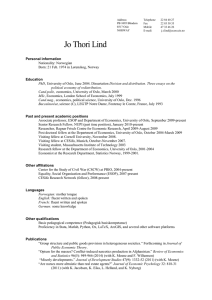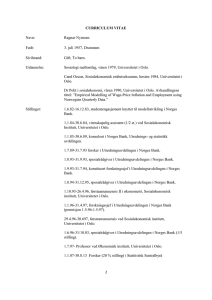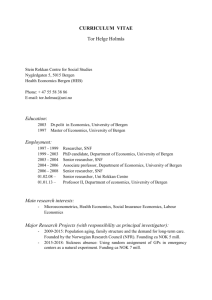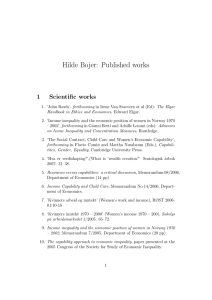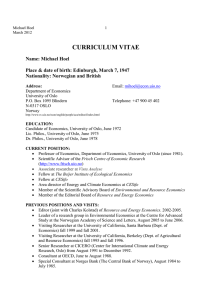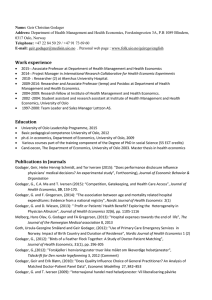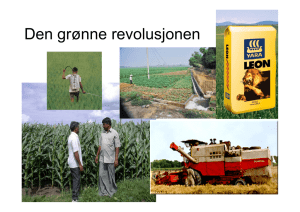INSTITUTT FOR ØKONOMI S
advertisement
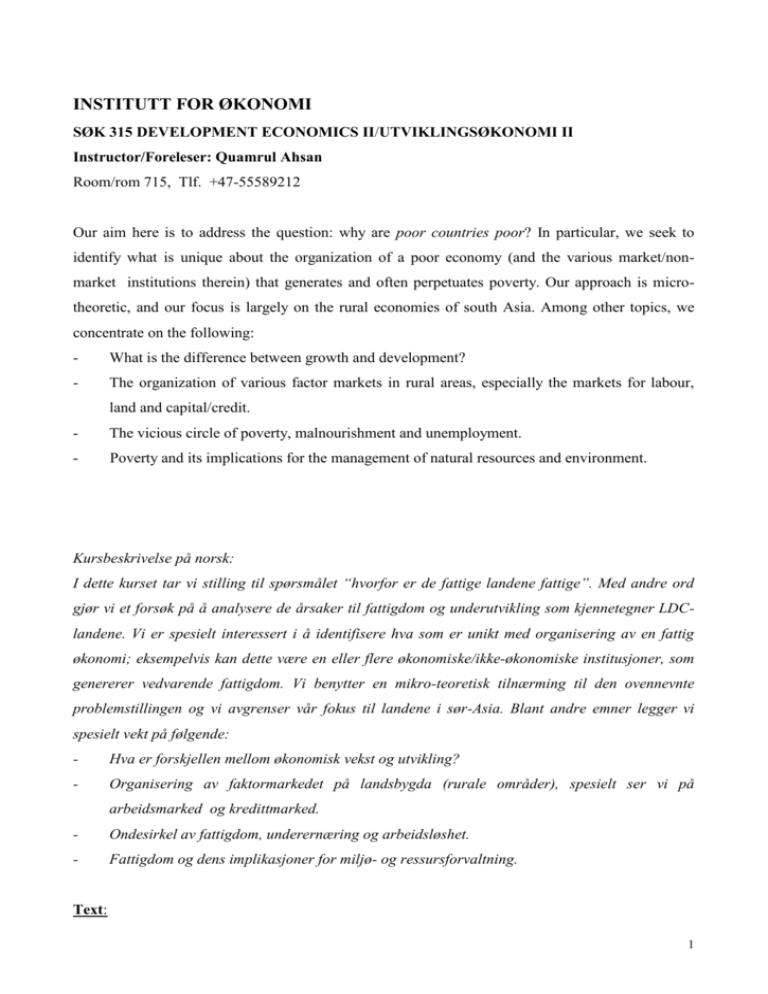
INSTITUTT FOR ØKONOMI SØK 315 DEVELOPMENT ECONOMICS II/UTVIKLINGSØKONOMI II Instructor/Foreleser: Quamrul Ahsan Room/rom 715, Tlf. +47-55589212 Our aim here is to address the question: why are poor countries poor? In particular, we seek to identify what is unique about the organization of a poor economy (and the various market/nonmarket institutions therein) that generates and often perpetuates poverty. Our approach is microtheoretic, and our focus is largely on the rural economies of south Asia. Among other topics, we concentrate on the following: - What is the difference between growth and development? - The organization of various factor markets in rural areas, especially the markets for labour, land and capital/credit. - The vicious circle of poverty, malnourishment and unemployment. - Poverty and its implications for the management of natural resources and environment. Kursbeskrivelse på norsk: I dette kurset tar vi stilling til spørsmålet “hvorfor er de fattige landene fattige”. Med andre ord gjør vi et forsøk på å analysere de årsaker til fattigdom og underutvikling som kjennetegner LDClandene. Vi er spesielt interessert i å identifisere hva som er unikt med organisering av en fattig økonomi; eksempelvis kan dette være en eller flere økonomiske/ikke-økonomiske institusjoner, som genererer vedvarende fattigdom. Vi benytter en mikro-teoretisk tilnærming til den ovennevnte problemstillingen og vi avgrenser vår fokus til landene i sør-Asia. Blant andre emner legger vi spesielt vekt på følgende: - Hva er forskjellen mellom økonomisk vekst og utvikling? - Organisering av faktormarkedet på landsbygda (rurale områder), spesielt ser vi på arbeidsmarked og kredittmarked. - Ondesirkel av fattigdom, underernæring og arbeidsløshet. - Fattigdom og dens implikasjoner for miljø- og ressursforvaltning. Text: 1 RAY, Debraj: Development Economics, Princeton University Press 1998 Supplementary Texts BASU, Kaushik: Analytical Development Economics, MIT Press 1997 JONES, Charles I.: Introduction to Economic Growth, second edition, Norton 2002 All starred materials are required reading. 1. Introduction -The meaning of development - some implications of development. * RAY, chapters 1, 2. * Sen, Amartya, “The concept of Development”, in H. Chenery and T.N. Srinivasan (Eds.), Handbook of Development Economics, Vol 1, North Holland, 1988. 2. Growth and Development 2.1. What is the difference between growth and development? - The relationship between the “new growth theory” and economic development. *RAY, chapters 3 and 4. *BASU, chapter 3. *JONES, chap 2. 2.2. Income Inequality and economic development *RAY, chapters 6 and 7. 3. The “Dual Economy” Model of Development 3.1. The Lewis Model - Rural-to-urban Migration and Employment Growth. *RAY, chapter 10 *BASU, chapter 7, 8 3.2. More Recent Models of Dual Economy -The Labour Turnover Model *BASU, chapter 9 4. Organization of a Rural Economy 4.1. Rural Market Imperfections: Land Market *RAY, chapters 11 and 12 4.2. Rural Labour Market 2 *RAY, chapter 13 Rosenzweig, M. “Labour Markets in Low-income Countries” Handbook of Development Economics, Vol.1, Ch. 15., 1988. 4.3. Rural Credit Market, Insurance and Interlinked Contracts *RAY, chapters 14 and 15 Bardhan, P.K., “Interlocking Factor Markets and Agrarian Development”, Oxford Economic Paper, 32(1), 1980. Besley, T. “Savings, Credit and Insurance” Handbook of Development Economics, 1992. Besley, T. And Coate, S., “Group Lending, Repayment Incentives and Social Collateral” Journal of Development Economics, Vol. 45, 1995. Hoff, K. And Stigtitz, J., “Introduction: Imperfect Information and Rural Credit Markets” World Bank Economic Review, Vol. 4, No. 3, 1990. 5. The Economics of Poverty, Malnutrition and Famines *RAY, chapter 8 Dasgupta, P. And Ray, D., “Inequality as a determinant of Malnutrition and Unemployment: Theory” Economic Journal, Dec. 1986. * Sen, A., “Ingredients of Famine Analysis: Availability and Entitlements” Quarterly Journal of Economics, 95, 1981. 6. Sustainable Development *Dasgupta, P. And Maler, K-G. (1996), “The Resource-Basis of Production and Consumption: An Economic Analysis.” In: Dasgupta, P. and Maler, K.G. (Eds.), The Environment and Emerging Development Issues, Clarendon Press. Panayotou, Theodore (1992), "Economics of Environmental Degradation: Problems, Causes and Responses." In Markandya, A. and Richardson, J. (Eds.), The Earthscan Reader in Environmental Economics, Earthscan Publications Ltd, London 1992. 3
